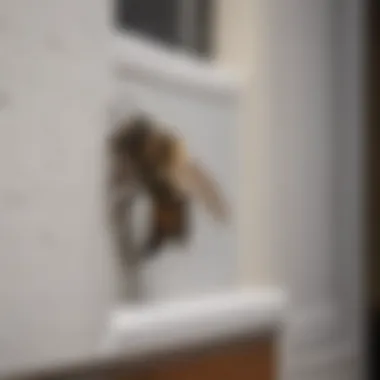Effective Strategies for Safely Managing Bees at Your Door


Intro
Encountering bees near your front door can be a concern for many homeowners. Understanding these insects is essential. Bees, while important pollinators, can act unpredictably, especially when they feel threatened. This article will equip you with effective strategies for addressing bees sensitively and effectively, emphasizing coexistence without compromising safety.
Understanding Bee Behavior
Bees typically follow certain behavior patterns. Recognizing these can assertively guide how one approaches the task of managing them. When bees are away from their hive, they are searching for food. Late spring and summer are peak times for bee activity. It’s critical to discern types of bees, as not all pose the same threat.
Types of Bees Commonly Found at Your Front Door
- Honey Bees: Generally eager to collect nectar. They tend to be less aggressive unless provoked.
- Bumblebees: Large and fuzzy, they are strong but non-aggressive. They are not likely to sting unless threatened.
- Wasps: More aggressive than bees. They can defend their nest fiercely and sting multiple times.
Understanding these distinctions lends clarity to addressing the issue of bees.
Effective Strategies
When dealing with bees, several practical strategies can be employed to manage their presence without hazardous outcomes. Prioritize safety and non-lethal removal methods.
Removal Techniques
- Wait it Out: If bees seem calm, consider leaving them alone. They often leave after foraging.
- Natural Deterrents: Spearmint or peppermint oil are useful in encouraging bees to move away. Placing these scents around the door can effectively repel them.
- Hiring Professiona's: When faced with befriending a larger bee colony, employing a pest control expert becomes necessary. This ensures safety for all individuals involved while addressing a larger concern responsibly.
Each method requires evaluating the situation and seeking to remove the bees delicately.
Simulating Unwelcoming Environments
Altering your front entrance can help discourage bees from approaching. An unsuitable environment is not merely an absence of friendly factors but holds practical deterrents. Consider the following adjustments:
- Lighting: Swapping to yellow or sodium bulbs may help, as these are less attractive to bees than regular lumens.
- Regulating Access: Use mesh or retractable screens as a barrier. They allow for ventilation while securing the area from uninvited guests.
Making Your Home Less Enticing to Bees
- Clear away fallen fruit and sugary items that draw bees.
- Keep surfaces clean and without residues that smell attractive.
A few simple adjustments can help maintain a peaceful entryway.
Finale
Addressing the issue of bees near your front door is a delicate balance. Employing cohabitative strategies preserves bee populations while ensuring your home remains an inviting and safe haven. By understanding their behavior and exploring effective methods to encourage relocation without harm, it is indeed possible to address bee concerns thoughtfully. It's essential to approach these pollinators with care, recognizing their role in our ecosystem.
Understanding Bee Behavior
Understanding bee behavior is essential for homeowners dealing with these insects near their front doors. Knowledge about how bees operate can help in effectively managing their presence. When approaching bees, it’s significant to recognize that they play a vital role in the ecosystem, especially in pollination. Decisions made during encounters can impact not only the immediate area but potentially larger ecosystems as well.
Types of Bees Commonly Found Near Homes


Several bee species are typically found close to residential areas. Honeybees are among the most common. They are often drawn to flowering plants and are known for their social structure. Bumblebees are also prevalent, usually nesting underground or in abandoned rodent holes. Solitary bees, like mason bees, are less aggressive and tend to nest in small crevices or hollow stems.
Recognizing these types helps target specific management strategies. For instance:
- Honeybees: Essential for diverse ecosystems. They are often busy collecting nectar, reducing aggression.
- Bumblebees: Larger and furry. They are attracted to blooming flowers but can defend their nests if provoked.
- Solitary bees: Non-aggressive and helpful as pollinators yet rarely build visible nests.
Reasons Bees are Attracted to Doorways
Bees are attracted to doorways for various reasons. First, doors provide easy access to nectar sources nearby. If there are flowering plants around the entrance, they may routinely visit. Additionally, some bees prefer humidity. Doorways that trap moisture can inadvertently encourage visitation, especially during warm months.
Other reasons include:
- Warmth: Bees enjoy warm spaces, particularly late in the day.
- Safety: Doorways may seem safe habitats to establish a new nest.
- Aromas: Scents from perfumes and cooking can entice bees toward your entry too.
The Ecological Importance of Bees
The ecological importance of bees cannot be overstated. They are responsible for pollinating a vast majority of flowering plants, which includes many crops vital to human food sources. This engagement with floral species supports biodiversity and promotes healthy ecosystems.
Key Points About Bee Contribution:
- Pollination is critical for many fruits, vegetables, and nuts. Without effective pollinators, these crops can suffer.
- Bees directly impact food variety available to consumers.
- Their decline risks severe implications for both natural ecosystems and agricultural sustainability.
Knowing about bees' contributions encourages thoughtful and sustainable management. Homeowners must consider sharing space harmoniously rather than strictly enforcing eradication.
"Conserving bee populations is not just about protecting these species; it’s foundational for preserving our global environment."
Identifying Bee Colonies
Identifying bee colonies is crucial for homeowners facing encounters with bees near their front doors. Understanding the presence of bee colonies helps in determining how to address the situation properly while considering the ecological importance of bees. Getting a grip on your environment enables effective handling of any bee-related issues that may arise. Knowing how to identify colonies can also help in ensuring safety for you, your family, and the bees themselves.
Signs of a Bee Presence
Noticing signs of bee presence is vital when assessing a possible colony near your entrance. Some common indicators that you might observe include:
- Frequent bee activity: If you see bees regularly returning to a certain spot or actively pollinating flowers close to your doorway, they may have a nearby nesting site.
- Swarms: Detecting a large group of bees in a floating mass near your property usually indicates they are seeking a new nesting location.
- Buzzing sounds: A buzzing noise in the vicinity, especially when you are near potential nesting spots like eaves or sheltered crevices, tends to suggest the presence of bees.
- Bee droppings: You may find small droppings on window sills or surfaces near your doorway.
Monitoring these signs helps to clarify whether bees are merely visiting or if they have established a colony nearby.
Determining if Bees are Aggressive
Understanding whether bees are aggressive can influence your next steps dramatically. The first thing to note is that not all bees display aggressive behavior. Here are some factors to assess:
- Species identification: Some bees, such as honey bees, are generally docile, while species like yellow jackets may be more territorial. Knowing which species is lurking around is essential for evaluation.
- Colony disturbance: If the bees feel threatened, they are more likely to react defensively. This may occur if people or pets invade their territory too closely.
- Behavioral cues: Watching how the bees react to nearby movements serves as a key indicator. If they seem relaxed, they may not pose a risk; however, if they swarm or chase you away, aggression is likely.
Being aware of these indicators enables homeowners to make informed decisions regarding local bee populations, helping ensure their safety and the well-being of these important pollinators.
Safety Measures Before Proceeding


Addressing a bee presence near your front door requires a careful approach. It is crucial to understand and implement safety measures before taking any action. While bees are generally not aggressive, unexpected encounters can become problematic. Ensuring personal safety and the safety of these important insects is paramount. Proper precautions can help minimize risks while allowing for a thoughtful approach to managing their presence.
Protective Gear to Consider
When preparing to handle bees, the right protective gear is essential. This minimizes the chance of stings and collects potential allergens from encounters. Here are several key items to consider:
- Beekeeping Smock: A lightweight, long-sleeved outfit that prevents stings while allowing airflow.
- Gloves: Use thick, long gloves made from durable materials. Avoid cotton as it can allow stingers to penetrate, choose leather or specialized beesuit gloves.
- Veil or Head Protection: A well-fitted bug veil protects the face and neck area, thereby preventing disturbing bees that fly near the head.
- Closed-Toe Boots: High-top boots can help prevent stings to the feet. Ensure they fit snugly to minimize space for bees to enter.
- Protective goggles: These can help in safeguarding the eyes from both stings and bee secretion. Choices that refrain from fogging will help maintain visibility during removal efforts.
Always ensure your gear fits properly and is intact before engaging with the bees.
Understanding the Risks of Bee Removal
Proceeding with bee removal involves various potential dangers. Understanding these risks is crucial in order to adopt safe removal practices. Possible risks include:
- Stings: The most immediate concern; even calm bees may react defensively if provoked. Stings can cause allergic reactions in some individuals and may necessitate medical attention.
- Aggression from the Colony: If bees sense a threat, they are likely to defend their nest. Aggressive swarming behavior can lead to multiple stings.
- Environmental Impact: Removing bees can disrupt local ecosystems. Bees play vital roles in pollination, and their absence or population decline must be considered.
- Legal Aspects: In some areas, it may be illegal to destroy certain species of bees. Failure to follow these regulations can result in legal consequences.
In summary, risk mitigation should guide any action taken regarding bee removal. Knowledge of potential hazards and sticking to protective measures will help categories of worries.
It is always recommended to start with non-invasive methods before considering removal options.
Preventive Measures to Deter Bees
Preventive measures are an essential component in managing bee presence near your front door. It's vital to address the environment around your entryway before any issues arise. By being proactive, you not only reduce the attraction for bees but also foster a living space that discourages their unwanted visits.
Considering the ecological role of bees, it's important to approach this subject with both understanding and care. Implementing preventive strategies can help maintain a balance between your needs and the well-being of these pollinators. Not only are these measures effective, but they are also advantageous for the aesthetics and functionality of your landscape.
Adjustments to Your Landscape
One of the most straightforward methods to deter bees is making adjustments to your landscape. This includes evaluating the types of plants and flowers around your front door. Bees are attracted to bright and fragrant flowers, so opting for plants that are less appealing can make a significant impact. For example, consider incorporating:
- Herbs: Such as lavender or rosemary can deter bees while providing culinary benefits.
- Vegetables: Grow plants like peppers or tomatoes, which are less attractive to bees.
- Non-Flowering Plants: Indigenous shrubs or trees are often excellent choices, providing greenery without attracting bees directly.
In addition to the types of plants, the layout is essential. Create barriers by spacing out flowering plants or placing non-flowering plants in between. Trimming bushes to dissuade bees from nesting nearby can augment this strategy. A well-thought-out landscape design contributes significantly to the preventive measures needed.
Effective Use of Scents and Repellents
Scents play a curious role in deterring bees. Certain oils and sprays can act as effective repellents. Products like peppermint oil, citrus oil, or even vinegar can be valuable allies in keeping bees at bay. These scents are generally unpleasant for bees yet harmless for homeowners. Consider introducing a few strategies:
- Essential Oils: Mix a few drops of peppermint or citrus essential oil with water in a spray bottle and spray around doorways.
- Vinegar Solutions: A blend of equal parts vinegar and water can function as a deterrent. Spray this mix weekly in areas where bees are likely to gather.
- Commercial Repellents: There are products specifically designed to deter bees. Follow manufacturer instructions to see how effectively they deterring bees without causing undue harm to other wildlife.
Understanding that while some scents may deter bees, other scents can attract them. Therefore, recognize the potential interaction between bees and your environment when choosing repellents. Regularly assessing your approaches and adapting them as necessary is vital for long-term success. Maintaining vigilance will indeed help in balancing your needs with ecological considerations.
**Always consider the safe practices when using repellents.
Methods for Safe Removal of Bees


Addressing bee issues safely is crucial. Bees play a significant role in our ecosystem. Removal can reduce risks of stings and damage while ensuring these pollinators thrive. This part examines techniques homeowners can use to manage bee presence responsibly.
DIY Techniques for Non-Aggressive Bees
Homeowners often prefer to handle minor bee issues themselves. Here are steps to consider:
- Wait and Observe: Taking time to understand bee behavior is vital. Often, bees will move on if they have not established a nest.
- Seal Entry Points: Check doors, windows, and other potential entrance points. Use screens or caulk to cover gaps where bees may enter.
- Natural Repellents: Some scents can deter bees. Essential oils like peppermint or citronella can work effectively. You can create a trap: mix sugar water with vinegar and place it away from doorways to attract them away from your entrance.
"When removing bees, patience is essential. Understanding their patterns often leads to safer outcomes."
- Gentle Removal: For bees that have settled, a gentle approach is best. Use a soft brush to encourage them away from areas they frequent.
- Timing: Early evening is often calmer. Bees are less active then. If you do need to shift their location, consider doing it at this time.
Precaution is key. Ensure not to provoke the bees. Moving quickly or waving your arms can lead to aggressive behavior.
When to Call a Professional
In certain situations, handling bees requires expert intervention. If danger presents itself, consider reaching out for professional help. Here are signs to do so:
- Large Colonies: A significant number of bees indicates an established hive. Professionals possess training to handle larger colonies safely.
- Aggressive Behavior: If bees are consistently aggressive or if someone has been stung multiple times, do not attempt removal yourself.
- Structural Damage: If the hive damages property or if your home is affected significantly, an expert is recommended to mitigate the situation.
It's prudent to have a professional specifically trained to remove honeybees, bumblebees, or wasps. Those individuals will employ safe removal techniques that also help save the bees when possible. Seek out a local bee removal specialist who has recurrent experience teaching sustainable approaches.
Post-Removal Care
Post-removal care is an essential aspect after addressing the presence of bees near your home. The procedures that follow hive removal play a significant role in ensuring not only the immediate safety of your entryway but also the long-term well-being of your surroundings. By adequately managing the area after bee removal, homeowners can minimize potential risks while fostering a sustainable approach to their environment.
Reassessing the Area for Future Risks
Once the bees have been removed, it is imperative to conduct a thorough reassessment of the location. This process helps identify any possible entry points or conditions that could draw in new colonies in the future. Here are a few considerations to evaluate:
- Check for Gaps and Cracks: Inspect your front door, windows, and nearby structures for any openings. Sealing these tightly can prevent new colonies from establishing.
- Observe Flowering Plants: While flowers can attract bees, some types can draw clusters that could lead to further infestations near your entryways. Evaluate plants that might be too inviting and consider replacing them with varieties less appealing to bees.
- Routine Monitoring: Regularly inspect the vicinity after removal. Keeping a consistent check allows for early detection of returning bees.
Maintaining a Bee-Friendly Environment
After ensuring your entryway is secure, consider shifting perspectives toward maintaining a bee-friendly atmosphere. It is essential to recognize bees as integral players in the ecosystem, contributing significantly to pollination and overall environmental health. Here are some practical tips:
- Plant Bee-Friendly Flowers: Selecting native plants that attract beneficial bees can enhance local biodiversity while lowering the odds of aggressive species taking over your space.
- Establish Controlled Habitats: If possible, create designated areas in your yard where bees can thrive. Planting a diverse medley of nectar-rich flowers away from the main thoroughfare could draw them away from the entry route.
- Educate Family and Neighbors: Promoting awareness about bee behavior can help your community foster better coexistence strategies. Knowledge leads to sympathizing with these pollinators instead of viewing them solely as a nuisance.
"While bees might seem intrusive, their function in nature speaks volumes. With careful attention after removal, we can safely enjoy their presence without compromising our living space."
By addressing the remnants of bee presence, actively checking the area for vulnerabilities, and fostering environments suitable for them, homeowners can manage potential challenges and invite a richer ecosystem into their lives.
Culmination
Addressing the presence of bees near your front door requires a nuanced approach that prioritizes both personal safety and the essential ecological role these creatures play. By understanding bee behavior and the reasons they may be attracted to your property, one lays the groundwork for effective living arrangements.
One of the primary considerations in this context is balancing safety without compromising the well-being of bees. They are crucial pollinators, and their decline could have significant repercussions on local ecosystems and food sources. Safeguarding your entryways while respecting their space underscores an informed approach—one that considers immediate needs as well as broader environmental health.
The strategies outlined provide actionable insights for dealing with bees in a way that prioritizes preventative measures, appropriate removal, and post-removal care. Informing yourself about effective landscaping adjustments, the hardwork of scents and repellents, and the most suitable times for calling professionals fosters an integrated experience.
Properly implemented solutions can lead to more than an occasional interruption at your doorstep. These strategies enhance one’s home environment, promote understanding of bee behavior, and foster a respectful coexistence with nature's pollinators.
"A responsible homeowner not only seeks comfort in their surroundings but understands and respects the delicate balance with the ecosystem."







